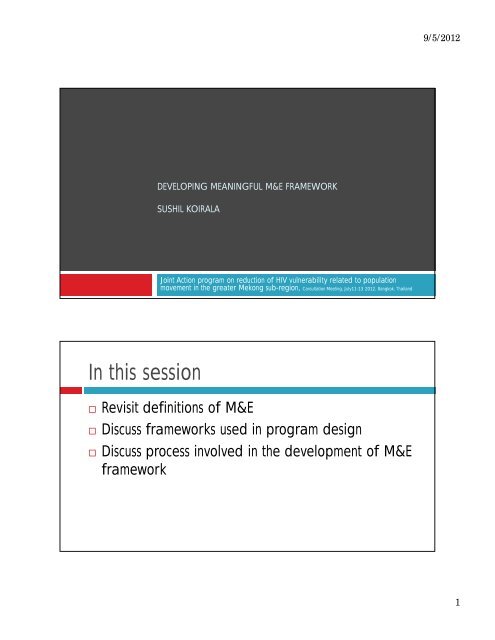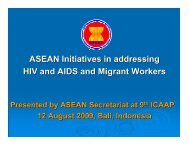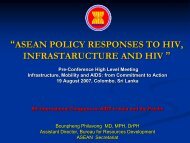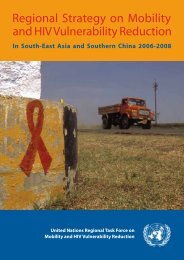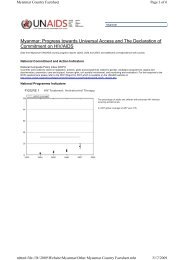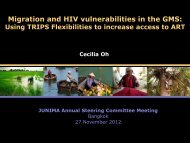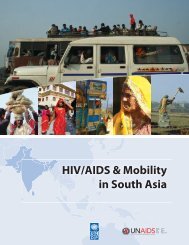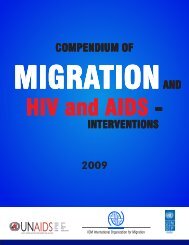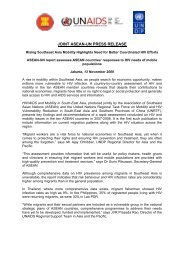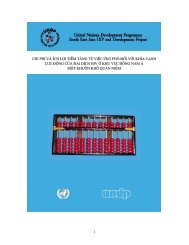Developing a Meaningful M&E Framework - JUNIMA.org
Developing a Meaningful M&E Framework - JUNIMA.org
Developing a Meaningful M&E Framework - JUNIMA.org
You also want an ePaper? Increase the reach of your titles
YUMPU automatically turns print PDFs into web optimized ePapers that Google loves.
9/5/2012DEVELOPING MEANINGFUL M&E FRAMEWORKSUSHIL KOIRALAJoint Action program on reduction of HIV vulnerability related to populationmovement in the greater Mekong sub-region, Consultation Meeting, July11-13 2012, Bangkok, ThailandIn this session Revisit definitions of M&E Discuss frameworks used in program design Discuss process involved in the development of M&Eframework1
9/5/2012M&EMonitoringEvaluationIs routine trackingUsually looks at key elements ofprogram performance (inputs,process and outputs)Conducted through regularreportingTo take corrective measuresIs episodic assessmentUsually looks at the change intargeted results that can beattributed to the programMeasures how well the programactivities have met expectedobjectivesHelps understanding the effectiveness,relevance and impact<strong>Framework</strong>s in program designBrief DescriptionConceptual <strong>Framework</strong> A diagram of a set ofrelationships betweenfactors that arebelieved to impact orlead to a targetconditionResult <strong>Framework</strong> Logically links programobjectives into strategicLogic Model<strong>Framework</strong>goalsLogically links inputs,processes, outputsand outcomesUse in ProgramManagementHelps determine whichfactor the program willinfluenceShows causalrelationships betweenprogram objectivesShows causalrelationship betweeninputs and objectivesBasis for Monitoringand EvaluationDoes not form the basisof M&E activities butcan help to explainprogram resultsForms the basis ofM&E activities at theobjective levelForms basis of M&Eactivities at allprogram levels2
9/5/2012Logic model framework It is a framework that logically summarizes the intendedoutcomes of a program and the steps to attain those It describes the inputs, activities or processes, outputs,outcomes, and impacts of a program and how theseelements work together to reach a particular goal It helps to identify key processes and can point topotential problems if goals are not achievedProblem statement:InputInput 1ProcessActivity 1OutputOutput 1Activity 2OutcomeActivity 6Outcome 1ImpactActiity 6Activity 2Outcome 1Input 2Activity 3Output 2ImpactActivity 4Input 3Activity 5Output 3Outcome 2Activity 43
9/5/2012Problem Statement: HIV Infection rates continue to rise, understanding theimportance of people knowing their HIV status, developing risk reduction strategiesand accessing treatment and care services.Inputs Activities Outputs Outcomes ImpactsIn conclusionIt is essential that all components are clearly stated since the design of the program.Vague activities are hard to implement and to monitorDifferent frameworks are used for M&E with its own strengths and limitations.Logical Model <strong>Framework</strong> is widely used to monitor and evaluate HIV programs<strong>Developing</strong> a M&E plan while designing a program provides better opportunity tothink out potential problems and identify possible solutions early-onEarly attention to M&E also helps in building a program that has an increasedchance to succeedProperly evaluated successful programs provide opportunities to replicatestrategies in similar setting elsewhere5
9/5/2012ReferencesMonitoring the Declaration of Commitment on HIV/AIDS: guidelines on construction of core indicators: UNGASS/UNAIDS(2010).The Monitoring and Evaluation Toolkit HIV, Tuberculosis, Malaria and Health and Community Systems Strengthening. TheGlobal Fund to Fight AIDS, Tuberculosis and Malaria. 2011 Monitoring and evaluation of health systems strengthening: An operational framework WHO, Geneva. October 2010 Guide for monitoring and evaluating national HIV testing and counselling (HTC) programmes: field-test version. WHO 2011 National AIDS Programmes. A Guide to Monitoring and Evaluation. UNAIDS (2000)National AIDS Programmes. A guide to indicators for monitoring and evaluating national HIVAIDS prevention programmes foryoung people. WHO (2004)Contents used in this presentation were adopted from M&E coursework available on Global Health eLearning Center athttp://www.cpc.unc.edu/measure/training/online-courses/related-online-courses/m-e-frameworks-for-hiv-aids-programs.htmlCOMPONENTS OF A M&E SYSTEMSUSHIL KOIRALA MA. MPH.Joint Action program on reduction of HIV vulnerability related to populationmovement in the greater Mekong sub-region, Consultation Meeting, July11-13 2012, Bangkok, Thailand6
9/5/2012In this session Review an example of logical model framework Discuss basics on indicators Discuss targets and timeline Discuss steps in developing program M&E systemJAP Area 2 JAP Area 2: To promote community-basedapproaches that reduce HIV vulnerability Strategic Objective 2.2: To provide awareness andinformation on HIV prevention and HIV care servicesto migrants, mobile population, and affectedcommunities (hereinafter referred as migrants)7
9/5/2012Activity-1Pre-departure orientation to migrants on HIV prevention,and access to HIV prevention, care and support servicesin destination countries Pre-departure training in the to perspective migrants, mobilepopulations and families at the community Pre-departure information provided to migrants – related toaccessing HIV/AIDS services; potential risks for each occupationand risk reduction measures-departure orientations in partnershipwith destination countries Reach the migrants and learn more about their conditionsActivity-2Mapping of available service for migrants, study on migration patternand migrant’s needs assessment Formally identify and institutionalize CBOs/NGOs working with affectedpopulations; SO government is aware of who is working with and what work isbeing done Program that would map and understand the migrants; analysis of motivationsfor migration; analysis of specific vulnerability context; specific understanding ofoccupations and mobility (movement – from source country) Get information from migrants themselves; partnership with NGOs and use ofcommunity networks to understand migrants Lao – profile of migrant population to develop appropriate and specificinformation (i.e. sex workers); including potential risks (part. for women)8
9/5/2012Activity-3 Peer led outreach based HIV preventionintervention with referral to VCT, treatment andcare services Distribution of IEC material Community forums Following identification, then develop/build capacity ofCBOs to work with community in developing/providing.Activity-4In-country, cross-border and regional coordination and collaboration FP; Government and civil society collaboration, HIV national focal point, Ministry of Publichealth and provincial level. Interaction and coordination between civil societies at both sides of the border Pre-departure program needs to be coordinated at host countries (i.e. ensure services formigrant as contained in the information package is available) Intensive workshop Bilateral coordination and cooperation at cross-border for prevention programs (i.e.awareness raising for legal and illegal migrants) Mechanisms between and among CSOs in receiving and sending countries; Mechanisms forcoordination between CSOs and governments Forum where CSOs and governments to have an exchange in addressing migrant issues9
9/5/2012Activity-5 Access to legal support in destination countries Activities to link migrants with legal support, not justhealth servicesLogical framework (example)Goal: To Reduce vulnerability and promote access to HIV prevention, treatment,care and support among migrants, mobile population, and affected communities inGMS countries.JAP Area 2: To promote community-based approaches that reduce HIV vulnerabilityStrategic Objective 2.2: To provide awareness and information on HIV preventionand HIV care services to migrants, mobile population, and affected communities(hereinafter referred as migrants)Problem Statement: Migrants are in increased risk of acquiring HIV and often facedifficulties accessing basic HIV prevention, care and support services. A peer ledintervention with proper access to quality care is proven to be an effectiveintervention10
9/5/2012InputProcess/activitiesOutputOutcomeImpactActivity 2Outcome 1Human ResourcesFunding fromgovernment and donorsNational responsibleagency for coordinationAvailable CBOs and otherimplementing partnersGuidelines, IEC/BCCmaterials and condomsPre-departure HIVprevention interventionPeer led outreach activitiesService mapping, Needsassessment and study onmigration patternNational, bilateral andregional coordinationand collaborationAccess to legal support indestination countriesMigrants reached withneed based tailored HIVprevention interventionImproved knowledge onavailable services, needsof migrants and theirmobility patternsIncreased cross-bordercollaboration and supportfrom policy levelIncrease in migrantsregistered in healthinsurance programAdaptation of sustainedHIV preventive behaviorActivity 6Increase on knowledge anHIV and self-efficacyImproved referral to HVtreatment and careservices (in country andacross borders)Improved access toquality treatment andcareReduced HIV transmissionActiity 6Reduction of HIV relatedearly mortalityActivity 4Monitoring?What are the key success factors? )(priority)Can we quantify the output? (measureable)How are we going to measure it? (feasible)How often and when we are going to measure it? (time-bound)Is it possible to get this information from the existing sources? (costeffective)How are we going to use the information? (use)How expensive it is to measure it? (affordable)11
9/5/2012Indicators Indicators are measurable characteristic or variable,which represent project progress Monitoring and evaluation requires indicators thatare specific, measurable, attainable, relevant, andtime-bound (SMART)Sample indicator (and what it is looking at ?)Inputs:Amount in USD made available for the implementation of HIV prevention, care and support programamong on migrants (financial commitment)Number of BCC materials (posters, brochures) made available for the program ( use of existingrecourses/saving)Activities:Number of migrants reached through pre-departure orientation program (improved coverage)Number of migrants reached though peer led outreach based interventions (improved coverage)Number of cross-border collaboration meetings held (improved, coordination, collaboration andreferral-proxy)Number of migrants receiving legal assistance for registration in health insurance program (Improvedaccess-proxy)12
9/5/2012Sample indicator (and what it is looking at ?)Output:Number of migrants reached with need based tailored HIV prevention intervention ( improved coverage)Percentage of migrants registered in health insurance program (improved access)Percentage of migrants correctly identifying at-least three methods of HIV transmission (improved knowledge)Number of migrants who are referred to and have received at-least one service from HIV health service center(improved coordination and referral) Number of migrants present with standard ART transfer card in health facility of the home country (improved referral)Outcome:Impact:Anti Retroviral Therapy coverage among migrants (Improved access)Percentage of migrants reporting the use of a condom their most recent sexual encounter( Improved HIV preventivebehavior)Number of new reported HIV infection among migrants ( Reduced incidence)Targets and timeline (Indicator data sheet)IndicatorsBaselinevalueSource/dateQuarterly TargetsCumulative targetY1 Y2 Y3 Y4Number of migrants reached though peer led outreachbased interventionsNumber of migrants receiving legal assistance forregistration in health insurance programNumber of migrants who are referred to and havereceived at-least one service from HIV health service centerNumber of migrants present with standard ART transfercard in health facility of the home countryNA NA 0 200000 470000 1700000 1700000NA NA 0 12000 45000 100000 10000NA NA 0 3000 15000 35000 35000NA NA 0 100 1500 15000 1500Anti Retroviral Therapy coverage among migrants 2% UNGASS Reports(GMS) -2010NA 5% NA 15% NAPercentage of migrants reporting the use of a condom theirmost recent sexual encounterNumber of new reported HIV infection among migrants (annually)47% IBBS (GMS) -210112000 NAP(GMS)2011NA 65% NA 85%% NA13000 11000 10000 7000 NA13
9/5/2012Defining indicators (according to the program context) Purpose Applicability Data collection frequency Measurement tool Method of measurement Numerator and Denominator InterpretationM&E design process (remaining tasks)Define M&E process and Information flow for the programRecording and reporting toolsReporting timeline and cyclesRecording and reporting responsibilities (country level and regional level)Validation of data and data quality assuranceFeedback process ( regular, coordination sharing meetings, annual reviews)M&E capacity building and supportive supervisionDissemination of informationData protection and confidentiality issuesEvaluation through Internal and external review14
9/5/2012In conclusionSMART indicators makes it easy to measure and interpretUsing standard indicators and adopting pre-devolved/tested tools ensures consistency and comparabilityacross the member countriesIt is important to distinguish between program M&E and information collection functions like activesurveillance, mapping, outreach based information collection etc. These form basis for M&E but are activitiesunder regular implementation.It is possible that a lot of program information are already inside existing national M&E system, IBBS etc.Using existing data sources saves money, time and mostly importantly reduces reporting burden to alreadyoverburdened people.Defining roles, timeline and process very clearly early-on helps in smooth implementation of M&E functionsChoosing only optimal number of indicators makes the system light and practicalEnsuring participation of all stakeholders in planning process develops ownership of the M&E system andthe program as a wholeResourcesMonitoring the Declaration of Commitment on HIV/AIDS: guidelines on construction of core indicators:UNGASS/UNAIDS (2010).The Monitoring and Evaluation Toolkit HIV, Tuberculosis, Malaria and Health and Community SystemsStrengthening. The Global Fund to Fight AIDS, Tuberculosis and Malaria. 2011Monitoring and evaluation of health systems strengthening: An operational framework WHO, Geneva.October 2010Guide for monitoring and evaluating national HIV testing and counselling (HTC) programmes: field-testversion. WHO 2011 National AIDS Programmes. A Guide to Monitoring and Evaluation. UNAIDS (2000)National AIDS Programmes. A guide to indicators for monitoring and evaluating national HIVAIDSprevention programmes for young people. WHO (2004)Content used in this presentation were adopted from Global Health eLearning Center available athttp://www.cpc.unc.edu/measure/training/online-courses/related-online-courses/m-e-frameworks-for-hivaids-programs.html15


